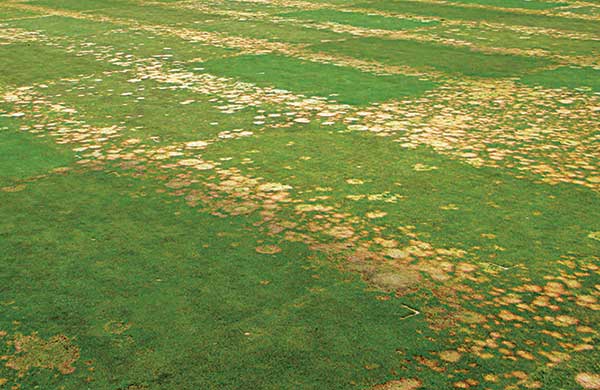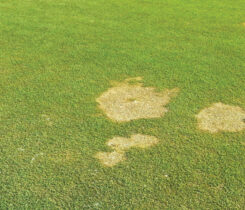Trading one problem for another

The experiment on a USGA sand-based putting green with Poa annua included three elemental sulfur treatments combined with four calcium sources. (Photo: Alec Kowalewski, Ph.D.)
Sometimes a cultural practice for one disease problem can increase another later in the year. Our research at Oregon State University found this to be the case when looking for alternative control measures for Microdochium patch (Microdochium nivale) on annual bluegrass (Poa annua).
Earlier research from the 1950s and 1970s indicated that lime increased Microdochium patch, while sulfur decreased severity. But, as seen by scientists at Rutgers University, acidic soil conditions can increase anthracnose severity. We conducted an experiment looking at the long-term effects of sulfur and calcium applications on the occurrence of Microdochium patch in the winter and anthracnose in the summer.
The research area was a USGA sand-based putting green with annual bluegrass. The experiment included three elemental sulfur treatments combined with four calcium sources. From January 2009 to May 2016, elemental sulfur was applied at 0.25 and 0.50 pound of sulfur per 1,000 square feet per month, totaling 3.0 and 6.0 pounds of sulfur per 1,000 square feet annually, respectively.
The four calcium treatments included no calcium, lime, gypsum or calcium phosphate. In May and September from 2005 to 2016, we applied all calcium sources after core cultivation at a rate of 12.5 pounds of product per 1,000 square feet.
From September through May of 2013 to 2016, we made fungicide applications of Banner Maxx II plus Turfcide 400 at 2.0 fluid ounces + 6.0 fluid ounces per 1,000 square feet, respectively. Fungicide applications were made on a per-plot basis when infection thresholds reached five spots measuring 0.25 inch in diameter or one spot exceeded 1 inch in diameter. Fungicides were not applied for anthracnose control from June to August.
As expected, sulfur helped to reduce the Microdochium patch, allowing for a more successful scouting-based fungicide program. However, sulfur also increased anthracnose in the absence of fungicide. Plots treated with lime had a higher pH than the other calcium sources. Yet, the calcium sources did not impact the number of fungicide treatments for Microdochium patch or anthracnose severity.
This project was funded in part by the USGA Green Section.












